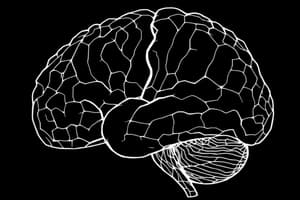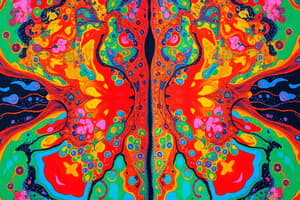Podcast
Questions and Answers
Damage to Meyer's loop in the temporal lobe results in which visual field defect?
Damage to Meyer's loop in the temporal lobe results in which visual field defect?
- Ipsilateral upper quadrantanopia
- Bitemporal hemianopia
- Contralateral lower quadrantanopia
- Contralateral upper quadrantanopia (correct)
A patient presents with difficulty perceiving motion after a stroke. Which area of the visual cortex is MOST likely affected?
A patient presents with difficulty perceiving motion after a stroke. Which area of the visual cortex is MOST likely affected?
- V5/MT (correct)
- V1
- IT (Inferotemporal Cortex)
- V4
What is the MOST likely visual deficit resulting from a lesion to the optic chiasm, such as from a pituitary adenoma?
What is the MOST likely visual deficit resulting from a lesion to the optic chiasm, such as from a pituitary adenoma?
- Scotoma
- Homonymous hemianopia
- Bitemporal hemianopia (correct)
- Upper quadrantanopia
Which cortical area is MOST associated with processing color information?
Which cortical area is MOST associated with processing color information?
A lesion in V1 would MOST likely result in what type of visual field defect?
A lesion in V1 would MOST likely result in what type of visual field defect?
Which of the following best describes the function of complex cells in the primary visual cortex (V1)?
Which of the following best describes the function of complex cells in the primary visual cortex (V1)?
What is the PRIMARY role of ocular dominance columns within the hypercolumn structure of the primary visual cortex (V1)?
What is the PRIMARY role of ocular dominance columns within the hypercolumn structure of the primary visual cortex (V1)?
Which stream is the magnocellular pathway MOST closely associated with?
Which stream is the magnocellular pathway MOST closely associated with?
A patient has difficulty reaching for objects but can still recognize them. This MOST likely indicates damage to which area?
A patient has difficulty reaching for objects but can still recognize them. This MOST likely indicates damage to which area?
Interblobs in V1 are primarily involved in what type of processing?
Interblobs in V1 are primarily involved in what type of processing?
Which layer of the primary visual cortex (V1) do parvocellular (P) pathway axons FIRST target?
Which layer of the primary visual cortex (V1) do parvocellular (P) pathway axons FIRST target?
What is the function of V2 pale stripes?
What is the function of V2 pale stripes?
If a person has a stroke affecting their PCA (Posterior Cerebral Artery) and experiences dorsal stream dysfunction, what would they MOST likely be able to do?
If a person has a stroke affecting their PCA (Posterior Cerebral Artery) and experiences dorsal stream dysfunction, what would they MOST likely be able to do?
Damage to the fusiform gyrus is MOST likely to result in which condition?
Damage to the fusiform gyrus is MOST likely to result in which condition?
What is the approximate shift in orientation preference between adjacent orientation columns within a V1 hypercolumn?
What is the approximate shift in orientation preference between adjacent orientation columns within a V1 hypercolumn?
Which area receives direct projections from V1 and is thought to be involved in integrating contours to perceive shapes?
Which area receives direct projections from V1 and is thought to be involved in integrating contours to perceive shapes?
Which specific feature do 'simple cells' in V1 respond to?
Which specific feature do 'simple cells' in V1 respond to?
What would be the MOST likely outcome of impaired binocular vision during the critical period in early development?
What would be the MOST likely outcome of impaired binocular vision during the critical period in early development?
Which of these best describes the function of V2 thick stripes?
Which of these best describes the function of V2 thick stripes?
Which layer of V1 receives input from the magnocellular LGN?
Which layer of V1 receives input from the magnocellular LGN?
Flashcards
Midget RGCs (P-cells)
Midget RGCs (P-cells)
Small receptive fields, project to parvocellular LGN, process detail/color.
Parasol RGCs (M-cells)
Parasol RGCs (M-cells)
Large receptive fields, project to magnocellular LGN, process motion.
Meyer's Loop
Meyer's Loop
Inferior fibers of the optic radiation carrying information about the upper visual field.
Baum's Loop
Baum's Loop
Signup and view all the flashcards
Meyer's Loop Lesion
Meyer's Loop Lesion
Signup and view all the flashcards
Optic Chiasm Lesion
Optic Chiasm Lesion
Signup and view all the flashcards
Simple Cells (V1 Layer 4)
Simple Cells (V1 Layer 4)
Signup and view all the flashcards
Complex Cells (V1 Layer 2/3)
Complex Cells (V1 Layer 2/3)
Signup and view all the flashcards
Blobs (V1 Layer 2/3)
Blobs (V1 Layer 2/3)
Signup and view all the flashcards
Scotoma
Scotoma
Signup and view all the flashcards
Ocular Dominance Columns
Ocular Dominance Columns
Signup and view all the flashcards
Orientation Columns
Orientation Columns
Signup and view all the flashcards
Blobs
Blobs
Signup and view all the flashcards
Interblobs
Interblobs
Signup and view all the flashcards
Strabismus
Strabismus
Signup and view all the flashcards
V4 Lesion
V4 Lesion
Signup and view all the flashcards
V5/MT Lesion
V5/MT Lesion
Signup and view all the flashcards
Inferotemporal Cortex (IT) Lesion
Inferotemporal Cortex (IT) Lesion
Signup and view all the flashcards
Balint's Syndrome
Balint's Syndrome
Signup and view all the flashcards
Magnocellular (M) Pathway
Magnocellular (M) Pathway
Signup and view all the flashcards
Study Notes
- The retina projects to the primary visual cortex (V1).
Anatomical Pathway
- Retinal Ganglion Cells (RGCs) include Midget (P-cells) with small receptive fields projecting to the parvocellular LGN for detail and color processing.
- Parasol (M-cells) have large receptive fields projecting to the magnocellular LGN for motion detection.
- Optic Radiation (Geniculocalcarine Tract) contains Meyer’s Loop (inferior fibers) carrying information from the upper visual field (lower retina).
- Baum’s Loop (superior fibers) carries information from the lower visual field (upper retina).
Clinical Correlation
- Lesions at Meyer's Loop (temporal lobe) result in contralateral upper quadrantanopia ("pie in the sky").
- Optic Chiasm lesions (e.g., pituitary adenoma) cause bitemporal hemianopia.
Receptive Fields in V1
- Simple Cells (Layer 4) respond to oriented edges and have ON/OFF regions for spatial summation.
- Complex Cells (Layer 2/3) detect moving edges and are direction-selective without distinct ON/OFF zones.
- Blobs (Layer 2/3) process color via input from the P-pathway.
Clinical Correlation
- Scotomas result from focal V1 lesions, causing blind spots in retinotopic locations.
Modular Organization of V1
- A hypercolumn (1 mm² of V1) contains ocular dominance columns with alternating left/right eye inputs, revealed by radiolabeled proline staining.
- Orientation columns show neurons shifting preference by 10° per column, arranged like a pinwheel.
- Blobs process color (cytochrome oxidase-rich), while interblobs process form and orientation.
Clinical Correlation
- Strabismus disrupts ocular dominance columns if binocular vision is impaired during the critical period.
Higher Visual Cortices (V2–V5/MT, IT)
- V2 contains thick stripes for motion (input from MT), pale stripes for color (input from V4), and interstripes for form (illusory contours).
- Lesions in V4 result in achromatopsia (color blindness).
- Lesions in V5/MT result in akinetopsia (inability to perceive motion).
- Inferotemporal Cortex (IT) lesions cause prosopagnosia (face blindness; fusiform gyrus lesion).
Clinical Correlation
- Balint’s Syndrome (Parietal Lesion) includes optic ataxia (inability to reach for objects) and simultanagnosia (inability to perceive whole scenes).
Sensory Processing Channels
- The Magnocellular (M) pathway is fast and motion-sensitive, projecting to the dorsal stream ("where"), targeting V1 layer 4Cα, then MT (V5).
- The Parvocellular (P) pathway is slow, processes color/detail, projects to the ventral stream ("what"), targeting V1 layer 4Cβ, then V4, and IT.
- V1 processes edges/orientation.
- V2 integrates contours.
- V4/V5 process object/motion.
- IT/PP handle recognition/spatial analysis.
Clinical Correlation
- Dorsal Stream Dysfunction (e.g., PCA stroke) preserves object recognition ("what") but impairs the ability to grasp them ("where").
High-Yield Summary for Exams
- V1 lesions cause contralateral homonymous hemianopia.
- Meyer’s Loop lesions result in upper quadrantanopia.
- M pathways are for Motion.
- P pathways are for Precision (color).
- Hypercolumns contain all features (orientation, ocular dominance, color) for one retinal point.
- Balint’s Syndrome and Prosopagnosia are frequently tested in neuro exams (e.g., identify faces/copy drawings).
Studying That Suits You
Use AI to generate personalized quizzes and flashcards to suit your learning preferences.




